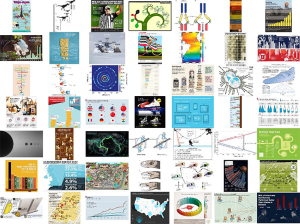Infographics continue to increase in popularity for organizations to communicate data. And this is with good reason: humans process information and remember information better when it is displayed visually. At the heart of inforgraphics though, is a good story. Collecting data and visualizing it is just a part of the creation process; every graphic should tell a story.
First, good data should be properly and rigorously processed and organized.
 Image source: Fast Co.
Image source: Fast Co.
The story structure (narrative or otherwise) should be crafted. An infographic should be thought of as a cognitive tool for understanding, and humans connect with stories. To create the story, ask “What do I want my reader to get from this graphic? What will the reader try to do with it?”
Then the graphics should be created. The most memorable visualizations contain elements that fall under the category of “human recognizable objects.” These are images with photographs, body parts, icons–things that people regularly encounter in their daily lives. Some additional data about what design elements make info graphics more memorable include:
- Visualizations with more than six colors are much more memorable than those with only a few colors or a black-and-white gradient.
- Visual density–what some of us might call “clutter”–is not a bad thing. In fact, images with a lot going on are significantly more memorable than minimalist approaches.
- Roundness is another hallmark of memorability.
- Basic bar graphs and charts are easy to forget: all the bar charts look alike.
- “Icons, images, and human-recognizable objects will instantly make [a visualization] more memorable,” she says. “But there’s this very careful caveat–and this is me speaking as a viz design person: make sure they’re helping your reader understand the main point of your data.” – Source
Great infographics that tell a complete story and leave a memory mark on the intended readers are not easy to create. And they take a lot of collaboration of different skills: data analysts, writers, designers and sometimes developers to make them interactive. But when they come together, great infographics are possible.

